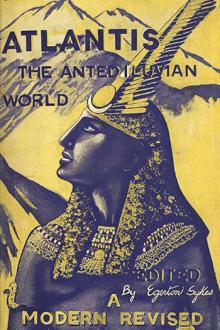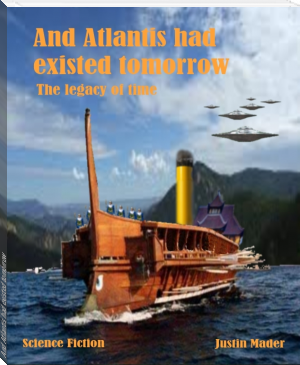Atlantis: The Antedeluvian World by Ignatius Donnelly (thriller novels to read .TXT) 📕

- Author: Ignatius Donnelly
- Performer: -
Book online «Atlantis: The Antedeluvian World by Ignatius Donnelly (thriller novels to read .TXT) 📕». Author Ignatius Donnelly
In Genesis the first man is represented as naked. The Aztec legend says, “The sun was much nearer the earth then than now, and his grateful warmth rendered clothing unnecessary.”
Even the temptation of Eve reappears in the American legends. Lord Kingsborough says: “The Toltecs had paintings of a garden, with a single tree standing in the midst; round the root of the tree is entwined a serpent, whose head appearing above the foliage displays the face of a woman. Torquemada admits the existence of this tradition among them, and agrees with the Indian historians, who affirm that this was the first woman in the world, who bore children, and from whom all mankind are descended.” (“Mexican Antiquities,” vol. viii., p. 19.) There is also a legend of Suchiquecal, who disobediently gathered roses from a tree, and thereby disgraced and injured herself and all her posterity. (“Mexican Antiquities,” vol. vi., p. 401.)
The legends of the Old World which underlie Genesis, and were used by Milton in the “Paradise Lost,” appear in the Mexican legends of a war of angels in heaven, and the fall of Zou-tem-que (Soutem, Satan—Arabic, Shatana?) and the other rebellious spirits.
We have seen that the Central Americans possessed striking parallels to the account of the Deluge in Genesis.
There is also a clearly established legend which singularly resembles the Bible record of the Tower of Babel.
Father Duran, in his MS. “Historia Antiqua de la Nueva Espana,” A.D.
1585, quotes from the lips of a native of Cholula, over one hundred years old, a version of the legend as to the building of the great pyramid of Cholula. It is as follows:
“In the beginning, before the light of the sun had been created, this land (Cholula) was in obscurity and darkness, and void of any created thing; all was a plain, without hill or elevation, encircled in every part by water, without tree or created thing; and immediately after the light and the sun arose in the east there appeared gigantic men of deformed stature and possessed the land, and desiring to see the nativity of the sun, as well as his occident, proposed to go and seek them. Dividing themselves into two parties, some journeyed to the west and others toward the east; these travelled; until the sea cut off their road, whereupon they determined to return to the place from which they started, and arriving at this place (Cholula), not finding the means of reaching the sun, enamored of his light and beauty, they determined to build a tower so high that its summit should reach the sky. Having collected materials for the purpose, they found a very adhesive clay and bitumen, with which they speedily commenced to build the tower; and having reared it to the greatest possible altitude, so that they say it reached to the sky, the Lord of the Heavens, enraged, said to the inhabitants of the sky, ‘Have you observed how they of the earth have built a high and haughty tower to mount hither, being enamored of the light of the sun and his beauty? Come and confound them, because it is not right that they of the earth, living in the flesh, should mingle with us.’ Immediately the inhabitants of the sky sallied forth like flashes of lightning; they destroyed the edifice, and divided and scattered its builders to all parts of the earth.”
RUINS OF THE TEMPLE OF CHOLULA.One can recognize in this legend the recollection, by a ruder race, of a highly civilized people; for only a highly civilized people would have attempted such a vast work. Their mental superiority and command of the arts gave them the character of giants who arrived from the East; who had divided into two great emigrations, one moving eastward (toward Europe), the other westward (toward America). They were sun-worshippers; for we are told “they were enamored of the light and beauty of the sun,”
and they built a high place for his worship.
The pyramid of Cholula is one of the greatest constructions ever erected by human hands. It is even now, in its ruined condition, 160 feet high, 1400 feet square at the base, and covers forty-five acres; we have only to remember that the greatest pyramid of Egypt, Cheops, covers but twelve or thirteen acres, to form some conception of the magnitude of this American structure.
It must not be forgotten that this legend was taken down by a Catholic priest, shortly after the conquest of Mexico, from the lips of an old Indian who was born before Columbus sailed from Spain.
Observe the resemblances between this legend and the Bible account of the building of the Tower of Babel:
“All was a plain without hill or elevation,” says the Indian legend.
“They found a plain in the land of Shinar, and they dwelt there,” says the Bible. They built of brick in both cases. “Let us build us a tower whose top may reach unto heaven,” says the Bible. “They determined to build a tower so high that its summit should reach the sky,” says the Indian legend. “And the Lord came down to see the city and the tower which the children of men had builded. And the Lord said, Behold . . .
nothing will be restrained from them which they have imagined to do. Go to, let us go down and confound them,” says the Bible record. “The Lord of the Heavens, enraged, said to the inhabitants of the sky, ‘Have you observed,’ etc. Come and confound them,” says the Indian record. “And the Lord scattered them abroad from thence on all the face of the earth,” says the Bible. “They scattered its builders to all parts of the earth,” says the Mexican legend.
Can any one doubt that these two legends must have sprung in some way from one another, or from some common source? There are enough points of difference to show that the American is not a servile copy of the Hebrew legend. In the former the story comes from a native of Cholula: it is told under the shadow of the mighty pyramid it commemorates; it is a local legend which he repeats. The men who built it, according to his account, were foreigners. They built it to reach the sun—that is to say, as a sun-temple; while in the Bible record Babel was built to perpetuate the glory of its architects. In the Indian legend the gods stop the work by a great storm, in the Bible account by confounding the speech of the people.
Both legends were probably derived from Atlantis, and referred to some gigantic structure of great height built by that people; and when the story emigrated to the east and west, it was in the one case affixed to the tower of the Chaldeans, and in the other to the pyramid of Cholula, precisely as we find the ark of the Deluge resting upon separate mountain-chains all the way from Greece to Armenia. In one form of the Tower of Babel legend, that of the Toltecs, we are told that the pyramid of Cholula was erected “as a means of escape from a second flood, should another occur.”
But the resemblances between Genesis and the American legends do not stop here.
We are told (Gen. ii., 21) that “the Lord God caused a deep sleep to fall upon Adam,” and while he slept God made Eve out of one of his ribs.
According to the Quiche tradition, there were four men from whom the races of the world descended (probably a recollection of the red, black, yellow, and white races); and these men were without wives, and the Creator made wives for them “while they slept.”
Some wicked misanthrope referred to these traditions when he said, “And man’s first sleep became his last repose.”
In Genesis (chap. iii., 22), “And the Lord God said, Behold, the man is become as one of us, to know good and evil: and now, lest he put forth his hand, and take also of the tree of life, and eat, and live forever:”
therefore God drove him out of the garden. In the Quiche legends we are told, “The gods feared that they had made men too perfect, and they breathed a cloud of mist over their vision.”
When the ancestors of the Quiches migrated to America the Divinity parted the sea for their passage, as the Red Sea was parted for the Israelites.
The story of Samson is paralleled in the history of a hero named Zipanca, told of in the “Popol Vuh,” who, being captured by his enemies and placed in a pit, pulled down the building in which his captors had assembled, and killed four hundred of them.
“There were giants in those days,” says the Bible. A great deal of the Central American history is taken up with the doings of an ancient race of giants called Quinames.
This parallelism runs through a hundred particulars: Both the Jews and Mexicans worshipped toward the east.
Both called the south “the right hand of the world.”
Both burnt incense toward the four corners of the earth.
Confession of sin and sacrifice of atonement were common to both peoples.
Both were punctilious about washings and ablutions.
Both believed in devils, and both were afflicted with leprosy.
Both considered women who died in childbirth as worthy of honor as soldiers who fell in battle.
Both punished adultery with stoning to death.
As David leaped and danced before the ark of the Lord, so did the Mexican monarchs before their idols.
Both had an ark, the abiding-place of an invisible god.
Both had a species of serpent-worship.
GREAT SERPENT MOUND, OHIO.Compare our representation of the great serpent-mound in Adams County, Ohio, with the following description of a great serpent-mound in Scotland:
“Serpent-worship in the West.—Some additional light appears to have been thrown upon ancient serpent-worship in the West by the recent archaeological explorations of Mr. John S. Phené, F.G.S., F.R.G.S., in Scotland. Mr. Phené has just investigated a curious earthen mound in Glen Feechan, Argyleshire, referred to by him, at the late meeting of the British Association in Edinburgh, as being in the form of a serpent or saurian. The mound, says the Scotsman, is a most perfect one. The head is a large cairn, and the body of the earthen reptile 300 feet long; and in the centre of the bead there were evidences, when Mr. Phené first visited it, of an altar having been placed there. The position with regard to Ben Cruachan is most remarkable. The three peaks are seen over the length of the reptile when a person is standing on the head, or cairn. The shape can only be seen so as to be understood when looked down upon from an elevation, as the outline cannot be understood unless the whole of it can be seen. This is most perfect when the spectator is on the bead of the animal form, or on the lofty rock to the west of it.
This mound corresponds almost entirely with one 700 feet long in America, an account of which was lately published, after careful survey, by Mr. Squier. The altar toward the head in each case agrees. In the American mound three rivers (also objects of worship with the ancients) were evidently identified. The number three was a sacred number in all ancient mythologies. The sinuous





Comments (0)